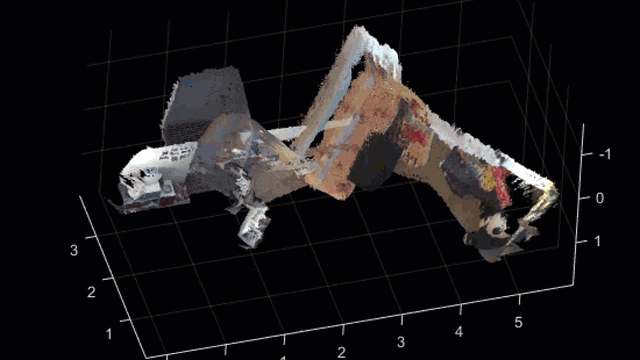Computer Vision System Toolbox In App Designer
Computer Vision Toolbox
Design and test computer vision, 3D vision, and video processing systems
Computer Vision Toolbox™ provides algorithms, functions, and apps for designing and testing computer vision, 3D vision, and video processing systems. You can perform object detection and tracking, as well as feature detection, extraction, and matching. For 3D vision, the toolbox supports single, stereo, and fisheye camera calibration; stereo vision; 3D reconstruction; and lidar and 3D point cloud processing. Computer vision apps automate ground truth labeling and camera calibration workflows.
You can train custom object detectors using deep learning and machine learning algorithms such as YOLO v2, Faster R-CNN, and ACF. For semantic segmentation you can use deep learning algorithms such as SegNet, U-Net, and DeepLab. Pretrained models let you detect faces, pedestrians, and other common objects.
You can accelerate your algorithms by running them on multicore processors and GPUs. Most toolbox algorithms support C/C++ code generation for integrating with existing code, desktop prototyping, and embedded vision system deployment.

Deep Learning and Machine Learning
Detect, recognize, and segment objects using deep learning and machine learning.
Object Detection and Recognition
Frameworks to train, evaluate, and deploy object detectors such as YOLO v2, Faster R-CNN, ACF, and Viola-Jones. Object recognition capability includes bag of visual words and OCR. Pretrained models detect faces, pedestrians, and other common objects.
-
Object Detection Using YOLO v2 Deep Learning
-
Faster R-CNN
-
Automatically Detect and Recognize Text in Natural Images

Semantic Segmentation
Segment images and 3D volumes by classifying individual pixels and voxels using networks such as SegNet, FCN, U-Net, and DeepLab v3+
-
Semantic Segmentation Tutorial
-
Semantic Segmentation of Multispectral Images
Ground Truth Labeling
Automate labeling for object detection, semantic segmentation, and scene classification using the Video Labeler and Image Labeler apps.
-
Getting Started with the Video Labeler App
-
Train an Object Detector or Semantic Segmentation Network from Ground Truth Data
-
Create Automation Algorithms for Labeling

Lidar and 3D Point Cloud Processing
Segment, cluster, downsample, denoise, register, and fit geometrical shapes
with lidar or 3D point cloud data.
Lidar and Point Cloud I/O
Read, write, and display point clouds from files, lidar, and RGB-D sensors.
-
Visualize Streaming 3D Point Cloud Data
-
Velodyne PCAP file reader
Point Cloud Registration
Register 3D point clouds using Normal-Distributions Transform (NDT), Iterative Closest Point (ICP), and Coherent Point Drift (CPD) algorithms.
-
Point Cloud Registration Tutorial
-
Register Point Clouds using Normal-Distributions Transform (NDT)
-
Register Point Clouds using Coherent Point Drift (CPD)
Segmentation and Shape Fitting
Segment point clouds into clusters and fit geometric shapes to point clouds. Segment ground plane in lidar data for automated driving and robotics applications.
-
Segment Organized 3D Range Data into Clusters
-
Segment Ground Points from Organized Lidar Data
-
Fit Multiple Planes to a Point Cloud


Camera Calibration
Estimate intrinsic, extrinsic, and lens-distortion parameters of cameras.
Single Camera Calibration
Automate checkerboard detection and calibrate pinhole and fisheye cameras using the Camera Calibrator app.
-
Using the Camera Calibrator App
-
Measuring Planar Objects with a Calibrated Camera
-
Fisheye Calibration
Stereo Camera Calibration
Calibrate a stereo pair to compute depth and reconstruct 3D scenes.
-
Using the Stereo Camera Calibrator App


Feature Detection, Extraction, and Matching
Feature-based workflows for object detection, image registration, and object recognition.
Feature Detection, Extraction, and Matching
Detect, extract, and match interesting features such as blobs, edges, and corners across multiple images.
-
Local Feature Detection and Extraction
-
Point Feature Types
-
Object Detection in a Cluttered Scene Using Point Feature Matching
Feature-Based Image Registration
Match features across multiple images to estimate geometric transforms between images and register image sequences.
-
Feature Based Panoramic Image Stitching
OpenCV Interface
Interface MATLAB with OpenCV-based projects.
-
Install and Use Computer Vision Toolbox OpenCV Interface
Deployment to Robot Hardware
View signals or modify parameters on deployed models. Make adjustments to your algorithms as they run on hardware.
Have Questions About Computer Vision Toolbox
30 Days of Exploration at Your Fingertips
Computer Vision System Toolbox In App Designer
Source: https://www.techsource-asia.com/computer-vision-toolbox
Posted by: hartleykinet1940.blogspot.com

0 Response to "Computer Vision System Toolbox In App Designer"
Post a Comment